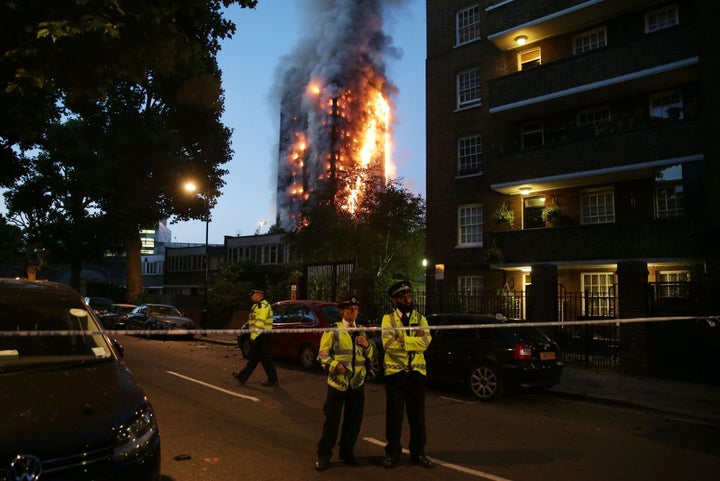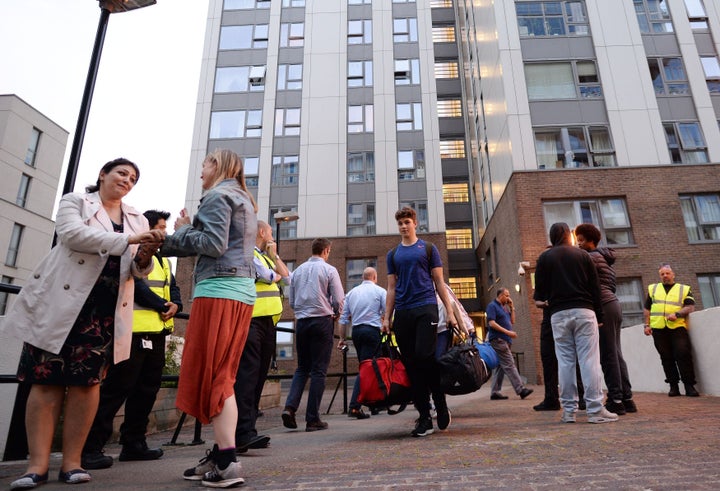
The Grenfell fire has exposed “decades of neglect” in public housing as councils scramble to replace tens of thousands of faulty fire doors, HuffPost UK can reveal.
Local authorities face huge bills to upgrade inadequate and badly-fitted doors, with one fire safety expert saying at least 1 million need replacing in the long-term.
Another said 70% of the doors inspected are not fit for purpose, and accused authorities of only seriously acting on the issue in the wake of the west London disaster.
While much of the focus since the blaze has been on cladding, the Grenfell Inquiry last week revealed the spread of the fire was partly due to more than 100 fire doors which did not meet building regulations.
Government tests on the same doors used in Grenfell, made by a company called Manse Masterdor, which ceased trading in 2014, revealed they withstood fire for just 15 minutes, half the amount of time they were supposed to.
Sajid Javid, who was then Communities Secretary, said there was “no evidence that this is a systemic issue”.
However, HuffPost has found the scale of the problems with fire doors appears to be significantly greater than portrayed after asking every London council what testing and replacement programmes had taken place since Grenfell – and in the last few years – to ensure doors were safely protecting millions of people.
The Freedom of Information requests revealed a mixed picture, with some authorities replacing thousands of entrance and communal doors and others saying they have found few problems with fire safety.
The investigation revealed that Lewisham council has a “proactive” programme currently “underway” that will see 15,500 doors replaced, of which 2,000 old doors still need to be removed.
Islington has identified just over 15,200 doors need “work of some kind to meet fire safety standards”, and has around 5,500 still to repair.
Meanwhile, Ealing council has replaced 3,000 doors since starting a replacement programme in 2016, and is about to embark on another year of improvements that will see many more changed.
Hillingdon has replaced 2,000 doors and has recently authorised a further £2m in investment for fire doors in high-rise blocks. Hounslow has found 1,335 doors that need replacing, with 1,111 completed to date.
Among smaller authorities, Havering has found 171 doors that need to be replaced, and the City of London says just seven doors are not up to standard.
Kensington and Chelsea Council, the borough council where Grenfell Tower stood, is to get rid of 4,000 doors, but only made the announcement in the aftermath of the tragedy. In contrast to the Government’s line, it said the doors were being replaced “as a matter of urgency”.

The revelations are only the tip of the iceberg, as some councils have yet to decide whether to replace the sub-standard Manse doors that the Ministry of Housing, Communities and Local Government has been mass testing.
Around 1,200 Manse doors have been identified in Barnet and 280 in Barking and Dagenham. Both councils are awaiting Whitehall guidance before deciding how to act.
Lambeth said 84 doors used in a 2014 refurbishment programme of council housing did not meet required standards, and that they will be replaced by October.
Hackney has identified 90 Manse doors and says that it is replacing them for “residents’ peace of mind”. They were among 257 doors it identified as in need of replacement during a post-Grenfell audit.
Meanwhile, the Government confirmed last year more than 1,000 fire doors were missing from four Camden tower blocks that were evacuated in the wake of the Grenfell fire.
Fire safety experts who regularly inspect tower blocks have told HuffPost the findings lay bare how a toxic combination of cuts to fire and council budgets, and confusion over fire safety laws, has led to years of neglect over fire doors specifically and fire safety more generally – problems that are only being tackled seriously in the aftermath of Grenfell.
The Ministry of Housing, Communities and Local Government acknowledges there are wide failures in the fire safety regime for high-rise residential buildings, and points to the fact it commissioned the Hackitt Review into fire safety and is testing fire doors.
Fire safety advisors point out that even if doors are providing the correct resistance to flames, they are often badly-fitted with the wrong material and overseen by council officials who lack expertise in the sector. Many of these problems were raised in in the Grenfell Inquiry by fire safety expert Prof Barbara Lane, who inspected the devastated building.

The principal legislation guiding councils is the Regulatory Reform (Fire Safety) Order 2005, which requires there to be a maintenance programme for fire safety systems.
The order, introduced by the Labour government, shifted the responsibility for fire safety away from fire brigades and on to the building owners. As a result, fire risk assessments are the centrepiece of the system of self-regulation, but contractors who often carry out the work need no formal qualifications to carry out the work.
Graham Fieldhouse, a fire safety expert who was drafted in by Southwark Council after the 2009 fire at Lakanal House, in which six people died, told HuffPost UK: “The problem is local authorities and companies are not getting the correct advice.
“I have seen many fire risk assessments that simply say ‘you need to get your doors checked by an expert’: guidance says doors should be checked twice a year. But I doubt they have been checked by a competent person in the last 10 years.”
His “educated guess” is that between 20,000 and 40,000 doors would need to be replaced with immediate effect, and at least a million doors might need to go into a programme of replacement.
He said: “It is the exception - not the rule - to see doors fitted well. There are many other issues, such as a lack of maintenance for fire doors, residents interfering by removing closers and wedging doors cutting into fire doors. These should be specific criminal offences.
“There is also the problem of fire doors being replaced with doors that have not been properly tested.”
Fieldhouse explains fire doors are vital to ‘compartmentation’ to the spread of the fire, and any breaches accelerate a blaze. “A door not set-up as tested becomes a big open door - a big hole - and breach of the compartmentation,” he says.
“It’s only because of Grenfell that there’s been an analysis of fire doors. They’re now repairing decades and decades of damage”
- Arnold Tarling
Arnold Tarling, another fire protection expert, points to the four tower blocks in Camden evacuated in the aftermath of the tragedy in Kensington because they were found to have the same cladding as Grenfell.
But, when given a thorough audit by the London Fire Brigade, the buildings’ fire doors were found to be missing, underlining “decades of failure to maintain or carry out the proper works – door after door after door failed”.
He said: “They have been neglected. It’s only when there’s a fire when you find things do or do not work. It’s only because of Grenfell that there’s been an analysis of fire doors. They’re now repairing decades and decades of damage.”
In damning evidence to the Grenfell Inquiry, Prof Lane spelled out the terrifying impact of what happens when fire doors fail.
She found that all of the fire doors between the fourth and 24th floors were “not compliant with fire test evidence relied upon at the time of installation”, and that this would have contributed to the spread of smoke and fire into the lobbies. Many of them failed in 20 minutes instead of the 60 minutes required by regulations.
“This failure would have materially affected the ability or willingness of occupants to escape independently through this space to the stair,” she wrote, adding that the failure of fire doors also affected the response of the fire service.
A Ministry of Housing, Communities and Local Government spokesman said: “Public safety is paramount. When we were informed about an issue with a Grenfell Tower fire door, we acted quickly to seek independent expert advice and established a wide-ranging investigation.
“Based on the results of these investigations to date, the expert panel advised the risk to public safety remains low. However, they advised there is a performance issue with Manse Masterdor which is why we took the responsible step of writing to relevant building owners setting out clear advice on what they should do.
“We asked Dame Judith Hackitt to carry out an independent review of building regulations and fire safety, and have made clear we will take action after her final report called for fundamental reform of the regulatory system.”
RESPONSES TO HUFFPOST:
Barking and Dagenham
Confirmed that 278 of the Manse Masterdor doors have been installed in high-rise blocks. A spokesman said: “The information on the installations was confirmed at the end of last week, work is being undertaken internally to deal with replacements.”
Barnet
Confirmed that 1,183 doors from the Manse Masterdor FD30 range were fitted in its tower blocks.
A spokeswoman for The Barnet Group, which manages public housing in the borough, said: “All the blocks with affected doors have up to date Fire Risk Assessments and robust fire mitigation measures in place. We are currently investigating options for replacement doors.
“In line with advice from government, we are undertaking a review of all Fire Risk Assessments for blocks with affected doors.
“The outcome of these assessments will be used to inform the timescales and programme for undertaking these works.”
Camden
A year ago, more than 1,000 fire doors in Camden were found to be missing from a four tower blocks, which were evacuated over ‘safety fears’ following the Grenfell fire. HuffPost has approached Camden for further details.
City of London
Seven Manse Masterdor doors identified. A spokesperson for the City of London Corporation said: “The security of our residents is paramount and naturally they have been concerned about fire safety.
“We have done a lot of work since last year to ensure residents are safe in their homes and to enhance fire safety on our estates.
“In the past year the City Corporation has moved from a three-yearly Fire Risk Assessment (FRA) to an annual independent FRA.
“All the City Corporation’s tenants are part of a programme of electrical testing and rewiring which includes new hard-wired fire detectors being installed.
“As part of its fire door replacement programme, the City Corporation is also upgrading front doors to provide up to 60 minutes of burn time across its estates.”
Ealing
A spokesman said: “The safety of our tenants and residents is always our first priority. About 3,000 doors have already been replaced as part of our three year programme of fire safety improvement works, which started in July 2016.
“As part of this we are currently reviewing 250 doors in line with Government guidance. All the doors in question are classed are in low rise blocks, which are low risk, with many doors opening onto open public balconies.”
Hackney
A spokesperson for Hackney Council said: “The council employed an independent company to test both these fire doors and will be testing another two of our most common fire doors in July. We have asked for a combined report on the results, which we expect at the end of August.
“The council reviewed all Fire Risk Assessments in our blocks and estates in the months following Grenfell and identified more than 20,000 individual actions from these. This has been a huge and time-consuming programme into which the council has rightly invested unprecedented resource and staff time.
“As part of this, 257 doors were identified as in need of replacement - this work is in progress. We are replacing 90 Manse Masterdors, which we have not tested, but are changing for resident peace of mind.”
Havering
Some 171 doors were replaced after a “sample door tested showed that this type of door is not compliant”. “A programme has been put in place to replace all doors that were identified as non-compliant in order that they will comply,” an FOI response said.
Hillingdon
A programme of door replacements began in 2017-18, and will cost £3.875m.
Fire doors have been replaced in 11 high-rise blocks and 21 sheltered homes, and was completed in March. In total it involved 1,017 front entrance doors and 1,224 communal doors.
The next phase of fire door replacements in medium and low rise blocks is to start this year.
A spokesman for Hillingdon Council said: “The safety of our residents is paramount and we have an ongoing rolling programme of inspections and maintenance works in all council-owned tower blocks.
“Prior to the Grenfell tragedy, the council had identified fire doors that did not adhere to the required standards and a door replacement programme was already underway. The council assures that all fire door sets have full third party accreditation and are fire tested as a complete assembly, compliant to the current British Standard. We do not accept doors that have global assessments.
“In cases where the council is unable to identify whether a door meets the fire or smoke resistant performance requirements detailed in the building regulation guidance documents part B, we arrange for planned replacements regardless. Our professional assessments are undertaken by fire risk assessors and fire door assessment specialists.
“In 2017/18, we invested £3.1 million in replacement fire doors in council housing, and an investment of £2 million was authorised by the leader of the council for fire doors in high-rise blocks on 20 June 2017.
“Further works will include the installation of a pilot sprinkler system in the communal area of a high rise block, followed by a planned programme for the remaining nine high rise blocks within the borough.
“Nearly a year on from the tragedy that occurred at Grenfell Tower, we want to reassure residents that fire safety is always prioritised at all council-owned buildings in Hillingdon.”
Hounslow
The council has undertaken a “flat front entrance doors replacement programme” in 35 high-rises and 26 sheltered homes. Some 1,335 doors have been identified as needing replacing, with 1,111 completed to date. It said work to replace doors in 17 high-rises and 23 sheltered homes will take place “in due course”.
A spokeswoman said: “The council do not have any Manse Masterdor fire doors on any council properties. The council is replacing individual flat entrance door-sets incorporating fire doors (FD30S) with intumescent strips and smoke seals to all council high-rise and sheltered housing schemes.”
Islington
In the last five years, the council identified 15,217 doors as needing work of some kind to meet fire safety standards. This included all types of work from replacing a missing door closer, replacing a lock, to refitting existing doors, and replacing doors.
So far work has been carried out at 7,709 properties - including replacing 2,616 doors - and work is ongoing at another 5,415 properties.
Councillor Diarmaid Ward, Islington Council’s executive member for housing and development, said: “Safety for residents in our estates is our top housing priority.
“We’re committed to ensuring all doors meet fire safety standards – this is an ongoing programme that is part of wider fire safety work in our estates.
“We will address all issues with fire doors – including replacing missing door closers or locks that don’t meet standards, or refitting doors that are no longer properly hung - as well as replacing doors where necessary.”
Kensington and Chelsea
In May, the council said more than 4,000 fire doors in the borough around Grenfell Tower are to be replaced by the council at a cost of £3.5 million, saying it “believes that the replacement programme must be started as a matter of urgency”.
Lambeth
Lambeth said 84 doors used in a 2014 refurbishment programme of council housing did not meet required standards.
A Lambeth Council spokesman said: “Lambeth was one of many councils who submitted a sample of these doors for testing to government.
“We have received confirmation that testing has advised that the particular type of doors do not consistently meet Fire Safety Performance requirements.
“Although the risk to safety is deemed to be low, we have reviewed our fire risk assessment relating to the relevant buildings which has one of these doors and door replacement for each affected property has been included into our ongoing programme of fire safety work.
“The door replacements should be complete by October.”
